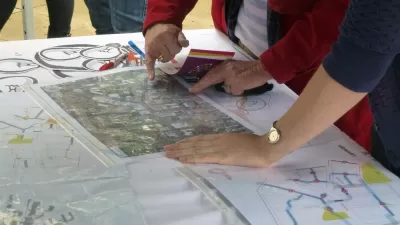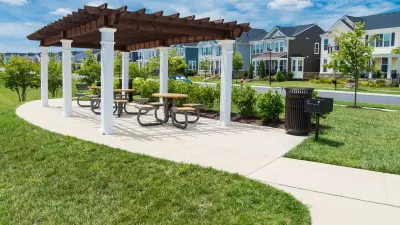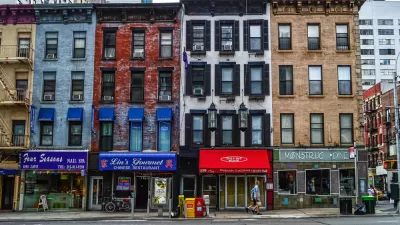I think many planners, in principle, agree that public involvement and grass-roots approaches to planning are necessary. The emphasis on the sheer numbers of people a plan "includes" is only one recent example of our profession’s emphasis on public involvement. But I think deep down, many colleagues see a distinctive split between involving the public and empowering them to implement. Involving is necessary and important to get any plan endorsed. But once that plan is complete, the public (residents, business owners, local stakeholders) is many times not regarded as an implementation partner except perhaps in roles of advocacy.
I think many planners, in principle, agree that public involvement and grass-roots approaches to planning are necessary. The emphasis on the sheer numbers of people a plan "includes" is only one recent example of our profession's emphasis on public involvement. But I think deep down, many colleagues see a distinctive split between involving the public and empowering them to implement. Involving is necessary and important to get any plan endorsed. But once that plan is complete, the public (residents, business owners, local stakeholders) is many times not regarded as an implementation partner except perhaps in roles of advocacy.
There is, of course, good reason for this. City, County or other agencies have budgets and an in-depth knowledge of how things work. Moreover, these agencies are charged with serving the public good so from that perspective, local residents are involved in implementation. And let's face it, many recommendations can't be completed by residents like building new streets or developing properties unless we return to a society that collectively builds our homes out of mud.
But if we think of city building as primarily an exercise in building with a capital "B" then we'll overlook the potential of do-it-yourself strategies. DIY urbanism - a newish catch phrase wrapped around an old idea – was effectively captured by Richard Sennett in the Uses of Disorder. (My apologies to him for the following overly reductive summary of his book.) In essence, a little anarchy (as in less centralized governing), he argued, would be good for society and cities in particular. It's the DIY ethic on the community scale – self reliance and empowerment would do an immense amount of good for all communities because people would be forced to organize themselves into action.
I'm not ready to eschew local government but I have been very interested in the increasing array of ideas that explore DIY urbanism whether explicitly or not. Block clean-ups are maybe the most elemental example but there's a wide range of examples from the traditional to the bizarre including guerilla painting, campgrounds, community gardens, townwatch, cows in the street, street pianos (thanks to fellow blogger Nate Berg for bringing this to my attention) and various examples of public art and festivals. The possibilities are limitless and although many DIY initiatives may often be temporary, the impact can be substantial.
Unfortunately, City agencies sometimes get in the way (maybe this is where a bit of anarchy can come in handy). Frustrations over "red tape," politics, onerous permitting, and other factors can effectively put a halt to some very good ideas that do not necessarily have to cost a lot of money. Keeping these factors in mind, DIY planning (sounds ironic doesn't it) could really be a three-fold process: 1) Emphasizing and developing creative ideas that can be done at the community level (in essence tapping the latent potential of the place); 2) Removing the barriers at the municipal level that prevent DIY activities; and 3) Implementing. The third aspect is key. Plans don't have to be just plans. It may be time we get out of our offices and build ourselves...with a lower "b." Philadelphia Mayor Michael Nutter's call to public service as well as his community service days strike the right tone from the municipal side with an emphasis on partnerships and government support.
Our office is exploring these ideas with a DIY open house in Wicker Park / Bucktown that is temporarily transforming a vacant storefront into an exhibit on the community's present and potential future. With the WPB Special Service Area, we filled the space with content and created public art using video to raise awareness about changes in the area and prompt participants for their ideas. (Ruthless plug alert) If you're reading this in Chicago, feel free to drop by 1275 N. Milwaukee Avenue the next two Saturdays and help the community plan for its future. It should be fun which is exactly what DIY should epitomize.

Alabama: Trump Terminates Settlements for Black Communities Harmed By Raw Sewage
Trump deemed the landmark civil rights agreement “illegal DEI and environmental justice policy.”

Planetizen Federal Action Tracker
A weekly monitor of how Trump’s orders and actions are impacting planners and planning in America.

The 120 Year Old Tiny Home Villages That Sheltered San Francisco’s Earthquake Refugees
More than a century ago, San Francisco mobilized to house thousands of residents displaced by the 1906 earthquake. Could their strategy offer a model for the present?

LA’s Tree Emergency Goes Beyond Vandalism
After a vandal destroyed dozens of downtown LA trees, Mayor Karen Bass vowed to replace them. Days later, she slashed the city’s tree budget.

Sacramento Leads Nation With Bus-Mounted Bike Lane Enforcement Cameras
The city is the first to use its bus-mounted traffic enforcement system to cite drivers who park or drive in bike lanes.

Seattle Voters Approve Social Housing Referendum
Voters approved a corporate tax to fund the city’s housing authority despite an opposition campaign funded by Amazon and Microsoft.
Urban Design for Planners 1: Software Tools
This six-course series explores essential urban design concepts using open source software and equips planners with the tools they need to participate fully in the urban design process.
Planning for Universal Design
Learn the tools for implementing Universal Design in planning regulations.
Ada County Highway District
Clanton & Associates, Inc.
Jessamine County Fiscal Court
Institute for Housing and Urban Development Studies (IHS)
City of Grandview
Harvard GSD Executive Education
Toledo-Lucas County Plan Commissions
Salt Lake City
NYU Wagner Graduate School of Public Service






























